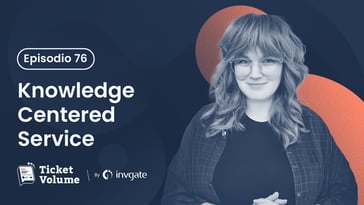In an era where customer experience (CX) reigns supreme, organizations constantly seek ways to understand and improve their customers' journey. User surveys have long been the default tool for gathering great data, but are they truly capturing the essence of the end-user behavior?
On the 42nd Episode of Ticket Volume, our IT podcast, Pasi Nikkanen, from HappySignals, shared his tips for applying customer satisfaction surveys best practices. He challenged the traditional tactic of obtaining customer feedback and offered a fresh perspective on how to unlock the true potential of surveys to perform better user experience research.
Nikkanen, the Co-Founder, Chief Growth Officer, and Podcast Host at HappySignals, boasts over two decades of experience in SaaS companies. He has held various positions ranging from Sales to Project, Portfolio, Strategy, and Leadership roles, showcasing his versatility in the industry.
Be sure to listen to the complete episode featuring Nikkanen. He gave away excellent tips that you may want to take note of. Moreover, you can sign up for our monthly live recordings and directly ask any questions during the session.

Nikkanen’s approach to customer satisfaction survey best practices
HappySignals, a survey company, focuses on improving the human experience of internal services. They believe that prioritizing human experience in organizations creates a positive and fulfilling work environment, leading to increased productivity and engagement.
|
|
"When you do things externally, we all know customer experience, you have usually two metrics, you have the heart, how people like your service, but then you also have dollars, how much are they buying from you. (...) This doesn't really fit into internal services because your company's employees (...) don't really have a choice, (...) so we created alignment with two very simple metrics, and of course, the heart is still very valid: how happy people are with the services, how do they experience it. But then the next thing was how much time you are wasting, so we thought that the productivity aspect is really the key to combined with the happiness." Pasi Nikkanen |
Nikkanen introduced their ITX framework, which stands for ID Experience Management. It involves measuring, sharing, identifying, and improving the employee experience. With that in mind, he shared their customer satisfaction survey best practices.
First of all, he explained that sharing experiences and measuring productivity plays a crucial role in enhancing internal services for organizations. It is vital to surface experiences for all IT personnel to improve understanding and focus. They make sure to identify metrics that highlight areas of productivity loss, allowing them to address these issues and ultimately increase productivity. Additionally, publishing a global benchmark report enables data gathering and identification of areas for improvement.
What he has learned from these productivity metrics is that organizations should focus on making employees more efficient with fewer resources. This can be achieved through automation and allocating resources to tackle difficult tasks. That is why relying solely on vanity metrics is insufficient; instead, surveys should be utilized to gather feedback and improve services and employee productivity.
He also pointed out that timing surveys correctly is paramount to capture the right context. Understanding the business context helps in making connections between survey results and improving service quality. So we should learn to analyze individual contexts to further enhance the overall service experience.
Continuous measurement is essential for tracking changes and making informed decisions. Nikkanen explained that relying solely on yearly surveys may overlook considerable changes or events that impact productivity. Therefore, organizations should continuously gather data and track changes to effectively manage employee experiences.
Lastly, it is relevant to put the spotlight on cultural differences in expectations. Western European countries, for example, have higher expectations due to advanced technology usage. Organizations need to adapt their services accordingly to meet the expectations of employees in different regions.
The future of experience research
Experience Management plays a vital role in organizational success, and understanding its multi-dimensional nature is essential. Companies with years of experience in this field can serve as valuable references, although their practices may not directly apply to newcomers.
Research shapes Experience Management strategies significantly. The upcoming release of the new version of the Global IT Experience Benchmark in late February indicated a commitment to ongoing research and improvement. Additionally, utilizing existing data provides insights into various aspects of employee experience, without relying solely on surveys. Analyzing changes in experience over time helps identify areas for improvement.
But, for Nikkanen experience management cannot be reduced to a single generic number. Instead, it requires an analysis based on factors such as service ownership or geographical location. This comprehensive understanding is central in identifying areas where experience is good or needs improvement.
He gave a very relatable example: Practical implementation of experience management resembles starting a fitness journey. Just as guidance is necessary to begin at a specific point and progress gradually, frameworks and best practices offer practical guidance for practitioners. However, it is important to strike a balance between prescriptive advice and individual exploration, as some organizations may prefer clear instructions while others enjoy experimenting and learning through trial and error.
And just like a gym membership, continuous improvement remains fundamental in experience research. Organizations must regularly evaluate strategies, measure their impact, and make necessary adjustments to meet evolving expectations. Collaboration and communication with stakeholders also play a vital role, as gathering data and ideas helps identify areas for improvement and drive innovation.
If you want to further learn about the importance of Experience Management, on episode 40 of Ticket Volume, Sally Mildren walks through the importance of this practice for revenue.
Improvements in employee experience
IT departments play a significant role in enhancing the employee experience. The COVID-19 pandemic has compelled companies to adapt and improve their services to meet the evolving needs of employees.
Self-service portals have now gained popularity and increased employee satisfaction. Efforts have been made to understand the factors contributing to the success of these portals.
|
|
"We'd realized that the happiness to the self-service portals like the ServiceNow Portal has now started to go up. It was for a long time it was the most hated channel, to be honest, still you just wanted to push it and it was maybe a bit selfish to try to push it there, but now I think we have found the things that you need to do that to make it successful." Pasi Nikkanen |
A challenge Nikkanen mentioned is the absence of external benchmarks for internal services like IT support. Unlike consumer products such as Apple or Android phones, there are no established benchmarks for internal services. This gap prompted the creation of HappySignals, which provides external benchmarks for internal services.
Overall, companies are making progress in improving employee experiences, particularly in areas like self-service portals. Benchmarking employee experiences is vital to pin out improvement areas and meet changing expectations.
Bottom line
All and all, it’s about understanding the multi-dimensional nature of experience. But, this is just a summary of Ticket Volume's episode featuring Pasi Nikkanen. There's a lot more to discover in the recording. Be sure to listen to the full conversation with Matt Beran to learn more about the customer satisfaction survey best practices.
You can find the full episode on popular platforms like Apple Podcasts, Spotify, YouTube, or any other podcast platform you prefer. Remember to subscribe if you're interested in joining the monthly live recordings!















